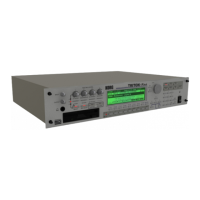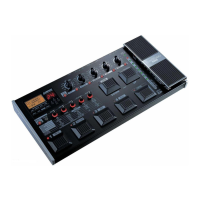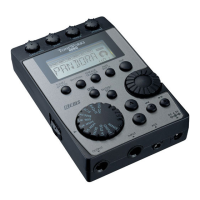1–2: OSC Basic (Oscillator Basic)
10
Transpose [–12…+12]
Sets the pitch in chromatic steps over a range of
±
1 octave.
Tune [–1200…+1200]
Adjusts the pitch in units of 1 cent (a chromatic step = 100 cents) over a range of
±
1 octave.
To change the pitch more than a chromatic step, you will normally use the
Transpose
setting.
However if you wish to produce an intentionally “stretched” sound (like the sound produced by
using pitch bend to raise the pitch), use the
Tune
setting.
1–2b: OSC2 Multisample
These parameters will appear if “1–1c: Oscillator Mode” is set to
double
. This multisample will
not sound for velocity values less than the value specified in “1–2c: Velocity Switch” for OSC2 Bot-
tom.
For the function and settings of these parameters, refer to “1–2a: OSC1 Multisample”.
1–2c: Velocity Switch
OSC1 Switch (OSC1 Velocity Switch) [1…127]
This velocity value will determine the point at which the High and Low multisamples specified
for oscillator 1 in “1–2a: OSC1 Multisample” will be switched.
Velocities above the value specified here will sound the High multisample.
OSC2 Switch (OSC2 Velocity Switch) [1…127]
This parameter will be displayed if “1–1c: Oscillator Mode” is set to
double
.
This velocity value will determine the point at which the High and Low multisamples specified
for oscillator 2 in “1–2b: OSC2 Multisample” will be switched.
Notes with velocity values higher than this setting will sound the multisample specified for High.
OSC2 Bottom (OSC2 Velocity Switch Bottom) [1…127]
This parameter will be displayed if “1–1c: Oscillator Mode” is set to
double
.
Velocities above the value specified here will sound the multisample of oscillator 2.
If this value is set higher than the OSC2 Switch setting, the Low multisample of oscillator 2
will never sound.
1–2d: OSC1 Drumkit
Drumkit [0…12]
Selects the drumkit.
Delay (Delay Time) [0ms…5000ms, KeyOff]
This sets the delay time from note-on until when the note sounds. With a setting of
KeyOff
, the
sound will begin at note-off. In this case, set the Amp EG Sustain Level to 0.
Octave [4'…32']
Specify the basic pitch of the oscillator in steps of one octave. When using a drumkit, be sure to set
this parameter to
8'
.
When editing a drumkit program, be absolutely sure to set this parameter to
8'
. With other set-
tings, the keyboard assignments of the drumkit will be thrown off.
Transpose [–12…+12]
This will adjust not the pitch but the location of the assigned drum kit.
If you do not need to change this, leave it set at
0
.
Tune [–1200…+1200]
This adjusts the pitch in units of 1 cent.
Pitch settings for each drum sound in a drum kit can be made in Global mode “5–1: Drumkit” (
☞
page 143 in this manual).

